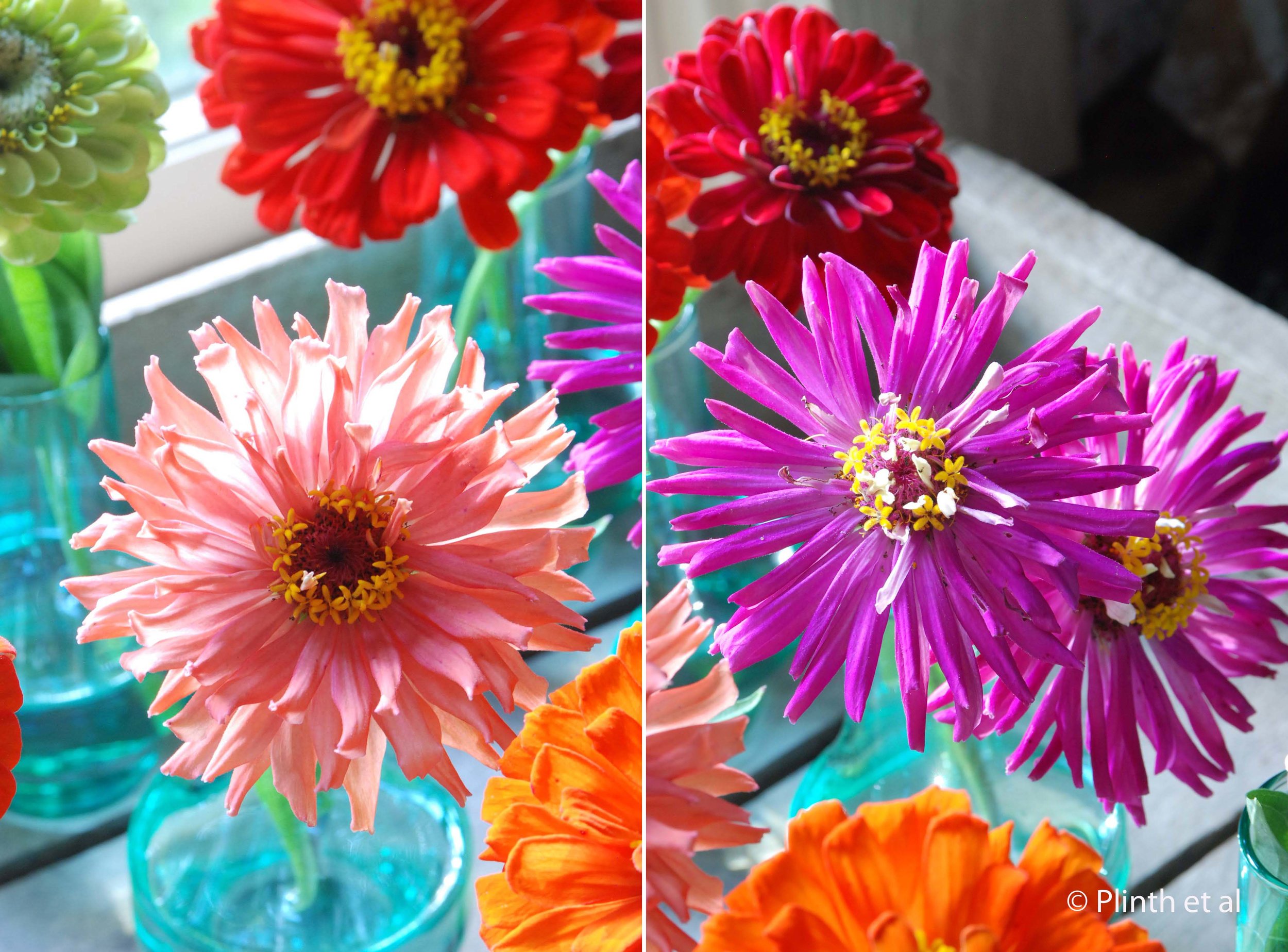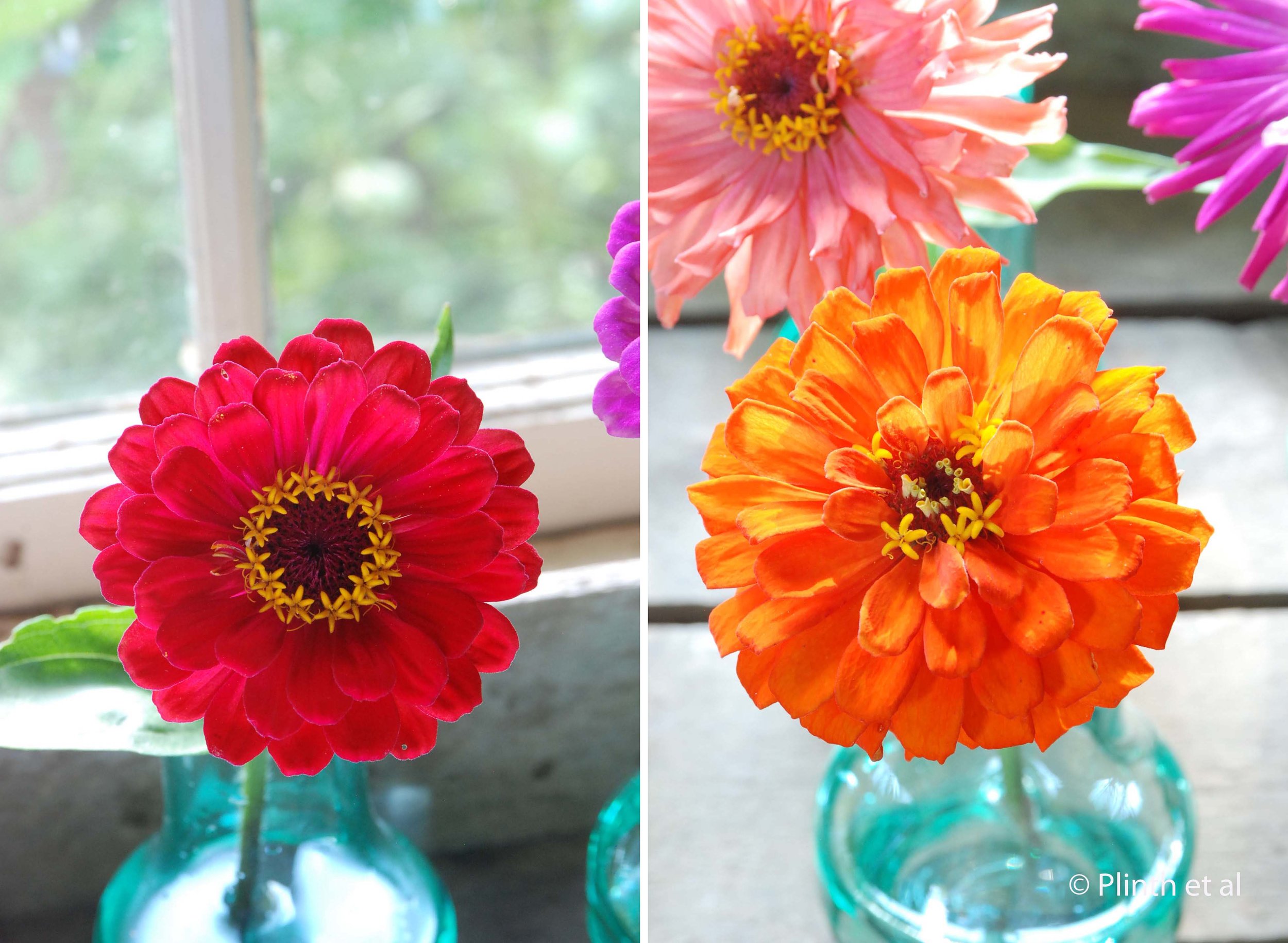Zappy Zinnias
Joyous and carefree as the halcyon summer days can be, zinnias bedazzle us with their unabashed brilliance. They look as if a child had gone unsupervised with a box of 1000 Crayola crayons, coloring with singular doggedness each flower. Zinnias are a fitting preclude before spectacular dahlias steal their thunder in autumn. They share the same New World (Mexican) origins as dahlias, and were likely grown by the Aztecs before being popularized in the Old World. The Swedish botanist Carl Linnaeus named zinnias after the German professor of botany and medicine Johann Zinn in 1856. Of the various species, Zinnia elegans is the progenitor of today's modern hybrids in various colors and forms.
Do not sow too early for zinnias dislike cold temperatures more than anything. Sowing too early will either result in poor germination or weak plants. When evening summer temperatures are in their 70s to 80s, then seeds or plants can safely grown outside. Although some sources recommend direct sowing to minimize root disturbance, sowing in pots can be successfully if the seedlings are gingerly handled and transplanted. By no means should planting be delayed once the seedlings have produced their first or second set of true leaves. I have had success producing zinnias this way, using them in summer containers.
The combination of summer warmth, water, and rich soil will cause the plants to romp away quickly and flower in no time. Although some gardeners get away with not staking their plants, staking does benefit the plants by encouraging straight and upright stems ideal for cutting. Stems broken either by weight, violent rainstorms, or human carelessness are not recoverable. They are best removed since they detract from the plants' appearance.
Zinnias are relatively trouble-free. In cool climates, botrytis or gray mold can be problematic. It can be easily diagnosed when the growth tips are covered with downy gray fuzz, which progresses downwards to the stems. Entire plants collapse as the stems crumple from the moldy tissues. Powdery mildew can befall plants in hot and humid climates if they have poor air circulation and are crowded. A good dose of baking soda mixed with water may mitigate the effect of powdery mildew. Japanese beetles may occasionally skeletonize the flowers or foliage, and picking them off early in the morning can control them.
Cactus-type zinnias are remarkably similar to cactus-type dahlias, and have the similar bold and bright colors to match. They are often tall, topping at 36".
'Pink Senorita' - Its salmon color and quilled petals make 'Pink Senorita' my top favorite, and an outstanding alternative for florists unable to source the ever popular Dahlia 'Cafe au Lait' earlier in summer. The color has the same transmutable hue as 'Cafe au Lait' and the flower size is comparable. I'm surprised that 'Pink Senorita' is not more widely grown in the local cut flower industry. 'Pink Senorita' can stand alone as a bouquet or sparingly mixed with chartreuse nicotiana ('Lime Green' or N. alata).
'Cactus-Flowered Lilac Emperor' - 'Cactus-Flowered Lilac Emperor' certainly has a regal bearing that matches 'Pink Senorita' in effect. Grow it with the dark purple Salvia 'Amistad' or 'Indigo Spires'.
Dahlia-flowered types are fully double and have dense petals packed tightly. They too can be tall plants at 36" in good conditions.
'Meteor' - A festive cherry-red, 'Meteor' literally ricochets from the sea of zinnia cultivars. It can be distinguished from 'Will Rogers' by its smaller size and less tiers of petals. The Parisian fashion house Christian Dior has a lipstick named 'zinnia red' that matches 'Meteor' in color.
'Orange King' - Part of the 'Benary Giant Series', 'Orange King' is a strong grower with large mandarin orange flowers that energize jaded senses. Grow it with bright yellow patrinia (Patrinia scabiosifolia) for a zappy duet.
'Polar Bear' - Clean whites are difficult to find in zinnias, but 'Polar Bear' is a clear winner. Its flowers are that pristine white, a good antidote to the fiery, bold hues more associated with zinnias. 'Polar Bear' goes well with 'Envy' or 'Green Envy' since the latter picks up the green tints of the former.
'Envy' - The cover flower of every book or article on green flowers, 'Envy' stands out for its distinctive chartreuse color. It is important to source good seed since color and size can be highly variable. Poorer strains have insipid colors missing that intensity. Renee's Garden Seeds' 'Green Envy' is a good strain.
Zinnias can be somewhat tricky to place in the garden since their bold colors can call attention to themselves at the expense of other plants. They require bold partners - at Great Dixter, variegated cannas and coleus were effective foliar foils for zinnias.
Any cut-flower garden is poorer without zinnias. Because zinnias have soft necks easily broken, they need to be handled carefully after picked for cut flowers. An exception may be reserved for 'Benary Giant Series', which do have sturdy necks. Cutting encourages more flowers to produce, and it's a treat to come away with an armful of zinnias for floral arrangements. I like using colored vases to highlight each individual flower, and a trip to Ikea yielded these inexpensive aqua blue-tinted bud vases made in France.
It is hardly surprising that zinnias have inspired endless painters, such as Vincent Van Gogh and Henri Fantin-Latour. Their paintbox colors have that captivating naivety, although the Victorians saw them in a significant way - zinnias mean 'thoughts of an absent friend". Hopefully the thoughts are those of happiness for nothing sad or depressing can be said about zinnias!
~Eric











